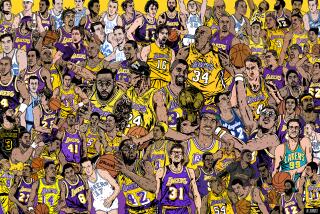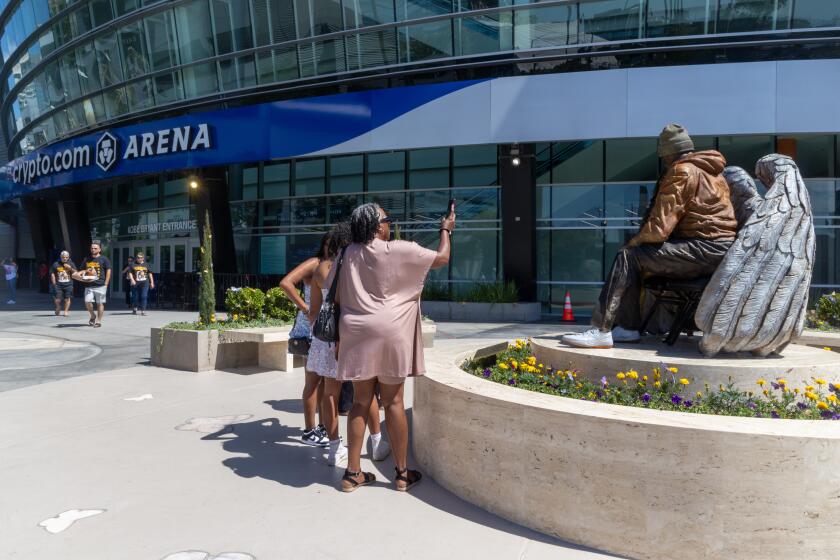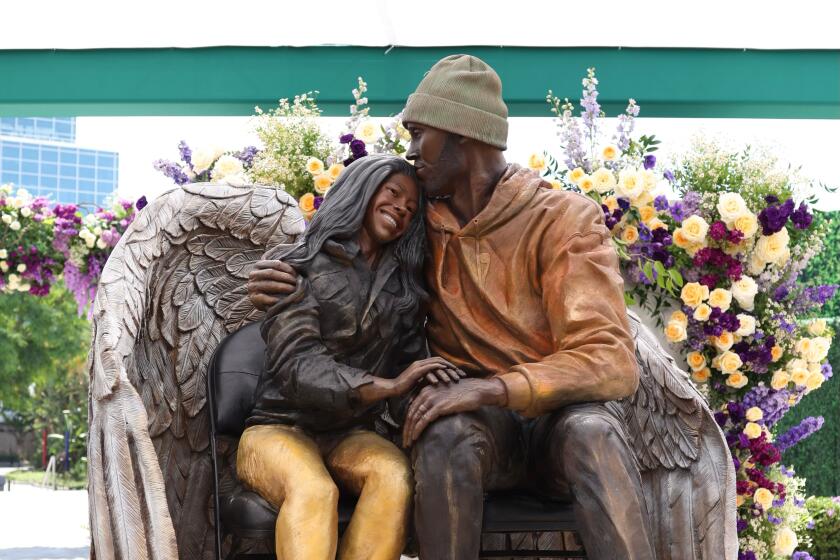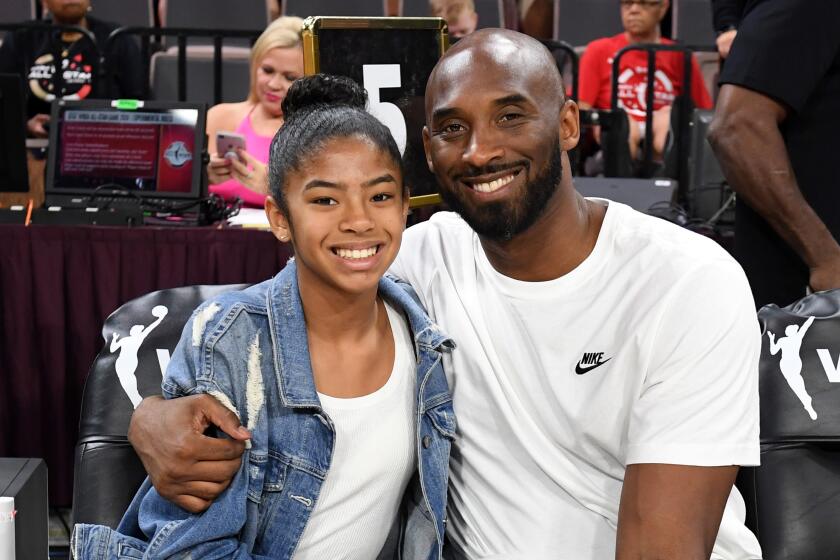RETURN TO NORM : He Might Not Be Stormin’ Back, but Nixon Isn’t About to Give Up
The team from Macon, small in stature and reputation, wasn’t supposed to beat the big schools from Atlanta and win the Georgia high school basketball title in 1973, but it did, led by Norm Nixon, all-state guard and senior class president.
“We went and kicked their butts in the state tournament, and they still called us flukes,” the star of the winning team recalled.
Later, after earning first-team All-Eastern 8 Conference honors in college at Duquesne, Nixon was passed over for a tryout for the 1976 Olympic team. Eddie Jordan, a second-team conference choice while at Rutgers, got an invitation.
“I’ve played against Norm ever since college, and Norm has always thought that he was considered a second-class citizen,” said John Lucas, the Seattle SuperSonics guard who attended the University of Maryland. “He never felt he got his due as a player or a person. That’s probably what keeps him motivated.”
Nixon was drafted by the Lakers in 1977--the second guard they picked and their third overall pick of the first round, behind Kenny Carr and Brad Davis. Carr lasted 3 seasons with the Lakers before moving on, Davis barely more than 1. Nixon spent 6 years there, starting for 2 National Basketball Assn. champions and being named an all-star once.
Finally, he had nothing more to prove.
“Once I was here, what else is there to say,” Nixon said. “I won championships and even led the team in scoring in the playoffs (in 1982).”
Except that now there’s this little matter of coming back after missing 2 seasons as a Clipper with a pair of unrelated injuries, serious enough on their own but magnified because of the sequence of events. Suddenly, at 33, he is an underdog again, having to prove that he belongs.
“I think that’s human nature,” Nixon said recently while relaxing at his Santa Monica home. “Coming from some small schools that didn’t get any recognition, I know if you have heart, (it) can make up for a lot of things.
“But I also know the general consensus among people is that athletes would just like to get the money and go. They think this is just a game we played when we were young and happened to be good enough to keep going and get paid for it at the same time. They don’t think about the countless hours in the gym and all the work it took to get here.”
All the work it took to get here?
Indeed, it was more than most people realize.
It might have happened when Mary Jo Nixon was pregnant with the third of her three boys, although no one knows for sure. She fell one day, and things were never the same again.
Soon after, she was diagnosed as having myasthenia gravis, a neuromuscular disease in which messages from the brain to muscles don’t get completed, causing weakness. The shocking thing is its suddenness, the way it strikes without warning.
Norm Nixon, that third child, knows all about it, because he spent hours as a youngster researching it, trying to understand why he never knew his mother healthy.
Sometimes they’d be walking together and Mary Jo would fall.
But despite the disease, Mary Jo, divorced from Elmer Nixon when their youngest son was 2, is far from disabled. She has remarried she’s Mary Jo McElhaney now and still is living in Macon.
“She’s stern and stubborn and tough,” said Norm, who usually talks with her every other day on the phone. “If I was in her house now and stayed out too late, she’d try to slap me down.”
Norm and his two older brothers, Ken and Ron, were brought up in Macon, about 70 miles southeast of Atlanta, by three women--their mother, their grandmother and a great aunt. They grew up in a lower-class neighborhood but never wanted for anything and even spent time helping others.
Norm attended the local Methodist church every Sunday and became an usher boy. Mary Jo wanted her sons raised properly, no matter her state of health, no matter their absence of wealth. Chores would be done, grades would be kept up, and heaven help the boy who didn’t show proper respect to elders.
Theirs was a family environment, with the grandmother and great aunt usually living close by in the neighborhood. All the better to look after the three boys when Mary Jo was unable.
“I’m sure she was a tremendous influence on him,” Don Richardson, Nixon’s high school basketball coach, said of Nixon’s mother. “She was the motivating factor for him. That guy worked harder than anybody else in the gym to be better, and there had to be somebody to give him that desire. I’m sure it was his mother, because he was with her more than anybody.”
That neighborhood obviously provided some climate for success. One close friend is a captain in the Army, and another recently left the service as a lieutenant. Two others opened a marketing company together in Philadelphia.
Norman Ellard Nixon, who played trumpet a little and was on the yearbook staff, was the athlete. Before graduating 17th in a class of about 700 at Southwest High School, he earned all-state honors in football and basketball. He also high jumped 6 feet 5 inches, winning a regional title, and ran the 440 and mile relays on the track team.
Basketball was his first love, but the recruiters figured that football should be his future. Nixon was so good as a defensive back and tailback that the most impressive scholarship offers were for that sport--from Auburn, Georgia, Florida, Kansas and Purdue, to name a few.
In basketball, the interest wasn’t nearly as great. A few of the local schools, which his brothers attended, and Georgia and Duquesne came calling.
He chose Duquesne, in Pittsburgh, and played on mostly mediocre teams. He left as the school record-holder in assists, joining the Lakers and becoming equally successful in the pros.
Strange as it seems now, in the wake of the injuries of the last 2 seasons, durability became one of his trademarks.
Discounting the 13 games he missed at the start of 1985-86 because of a contract holdout, Nixon appeared in 715 of a possible 725 regular-season games in his first 9 seasons in the NBA, even playing the first 2 games of the 1983 championship series against Philadelphia with a separated shoulder.
Along with Eric (Sleepy) Floyd, he is co-holder of the NBA record for the most minutes played in a game, having logged 64 in a 4-overtime marathon against Cleveland in 1980.
That all changed, of course, before 1986-87, which was to have been his third season with the Clippers. On July 23, 1986, Nixon was playing in the semifinals of a Broadway League softball tournament in New York’s Central Park.
Playing center field on the team of “Sweet Charity,” the production in which his wife, Debbie Allen, starred, Nixon charged after a shot to right and reached up to catch it. He didn’t see the hole in the field.
He stomped into it awkwardly with his left leg, the knee taking the jolt. Nixon knew immediately what had happened.
Someone brought ice for the knee and he lay there, in right-center field of a park 3,000 miles from home, his face covered by his cap while waiting 20 minutes for the ambulance to arrive. He didn’t want to face the world.
“I said to myself, ‘You really . . . up,’ ” Nixon says today.
He flew home to Los Angeles the next morning and underwent surgery for a torn tendon just above his knee the day after that. Eight weeks in a cast followed, and then the painful rehabilitation.
Nixon was ready by the time training camp started for 1987-88, with the Clippers counting on him for leadership after they had added three first-round draft choices. Everything was going well, too, as he played in all of the preseason games.
“I had just started to feel real good,” he said. “I felt the quickness coming back. I’ve always been a real intense player, so I could feel that edge coming back.”
But with 5 minutes left in the next-to-last practice session of camp at Cal State Dominguez Hills, the edge evaporated.
He had just crossed halfcourt while playing defense in a trap drill and cut to the middle. Everyone close by heard what happened next.
“It sounded like a big rubber band popped,” teammate Reggie Williams recalled.
Nixon, though, didn’t realize the injury’s severity at that moment. He thought Williams had accidentally kicked him in the right ankle while running past. Unlike Central Park, Nixon had no immediate notion of his fate this time.
Hoping to walk off the pain, he set the foot back on the floor.
But the leg didn’t stop. It kept sinking into his foot.
Nixon reached behind his ankle to feel the damage, but his fingers didn’t stop. They kept sinking into the middle of his foot.
The on-site diagnosis was confirmed later that day at the doctor’s office--ruptured Achilles’ tendon.
More surgery. More painful rehabilitation. More unexpected withdrawal from a life style he never had to do without. And whereas he at least had had strong, but fruitless, hopes of salvaging some of the season after the knee injury, since it had happened 3 months before camp opened, he knew from the start that 1987-88 was shot.
Time for Comeback No. 2.
For an instant, he questioned whether he could go through the arduous therapy sessions again. But once he started with the weights, walking barefoot on the beach to stimulate each toe and muscle, and doing hours of stretching exercises with his wife, it was as if he was leading a fast break. Full speed ahead, and don’t bother trying to stop him.
“I remember he had gotten all the way back from the knee injury, all the way through training camp and the practice games and then got hurt again just before the season,” said Tom Hille, who worked closely with Nixon on rehabilitation as the Clipper strength coach and the assistant strength and conditioning coach at USC. “So the doubt started to come back whether he could do it.
“We spent a lot of time working out and talking. The underlying thing behind (the comeback) was that he wanted to prove it to himself. I know he’s been saying that he wanted to show other people he could make it back, but I think deep down he really wanted to prove it to himself.”
Not so, according to Nixon.
“I wanted to come back because I want to play,” he said. “If my career was over now, I’d be totally satisfied because it was a great thing. I had a chance to win a championship, a chance to be an all-star. But I want to get there one more time. I want to get back to the playoffs and be in the mix of things with this team.
“I don’t need to prove to other people that I can still play. Those are all the wrong reasons. It was because I wanted to come back. I just enjoy playing.”
The motivation is that simple, he insists.
“I think Norm has a wonderful competitive spirit,” Clipper Coach Gene Shue said. “Most people could very easily have quit after the first injury, but he worked like hell. He was totally dedicated to coming back.
“Then he makes it all the way back and gets hurt again. So he worked his way back again. Believe me, there’s not a whole lot of people who would have done that.”
So what of this return to form?
It’s not complete, although Nixon believes that he’s headed in the right direction. He has made his comeback from the injuries, but he has not regained that edge.
Before missing the last 5 games, includes Friday night’s at San Antonio, with tendinitis in his right knee, he was one of only three Clippers to have played in each of the first 21 games. Along the way, his statistics were OK: 28.7 minutes, 9 points and 7 assists. But he’s shooting just 42.1% from the floor, and his quickness and speed aren’t up to standard, either.
“I think Norm is still a great player,” said Denver Nuggets guard Walter Davis, who, like Nixon, joined the NBA before the 1977-78 season. “What’s hurt him, obviously, is missing the competition for 2 years, so maybe he’s a bit more tentative now. But that’s just a matter of him getting comfortable.”
Nixon knows that better than anybody.
“I’m out on the court now, but it’s not like I’m on the court, if you know what I mean,” he said. “I still need to find myself. But because of all the things I’ve not been able to do right away in games, it’s like people are saying, ‘I don’t think he can do it.’
“Nobody is going to place their future in my hands. Because I’m not playing that well now, maybe they’re still thinking it’s better to invest in the long term. ‘Even if he gets all the way back, he still can only give us 2 or 3 more years of good basketball.’ That’s not a negative, that’s not a positive. That’s just reality.
“I was sitting around one day in the summer and dreaming about getting to play again,” Nixon said. “I was thinking that I would come right back and pick up where I’d left off. That hasn’t happened.
“It’s frustrating, not being able to do it all right now, but every game, I’m starting to feel better. One game, I ran by a guy while pushing the ball upcourt, and I hadn’t tried that because I didn’t think I had a real good handle on the situation. I’m also finding that a couple of the shots I used to take are still there. The rhythm is still there.”
“I said to myself, ‘I’m going to be good this year.’ There is none of that negative thinking--’If I can’t play I’m going to retire.’ I don’t think in those terms. I’m an eternal optimist.”
Nixon has had plenty of chances to get discouraged, beyond the injuries themselves.
First, he wasn’t protected in the expansion draft by the Clippers, who figured, correctly, that Charlotte and Miami would stay away because of the injuries and the 2 seasons he had left on a 5-year, $2.7-million contract. Then, the Clippers gave up the league’s best rebounder of 1987-88, Michael Cage, as part of a 3-team draft-day trade to acquire Gary Grant, the All-American point guard from Michigan.
Nixon, who said he never felt threatened by the arrival of the highly touted newcomer, started the first 15 games before being benched in favor of Grant. He later got another chance when Grant sprained an ankle.
What pains Nixon most is not being in at the end of close games. He recalls close losses this season to New York, to the Lakers, to Phoenix and wonders aloud that he might have made a difference. The trade-off would have been lack of speed and uncertain shooting streaks for sure-handed offensive direction, something the often erratic Grant can’t provide yet.
Nixon prides himself on being a clutch player. That’s one of his main selling points.
“I’ve never not been in down the stretch,” he said.
The 2 years away from the game hurt, but they weren’t wasted. Nixon, for instance, had the opportunity to watch his children, 4-year-old Vivian and 16-month-old Norman Jr., grow, lots of which he would have missed if he had been playing.
He also completed requirements for his undergraduate degree in general sciences with a minor in math by attending classes at UCLA, and has even taken a few courses toward a master’s.
Now, Norman Ellard Nixon, who plays a little piano and trumpet, speaks a little Spanish and does some ballet, is thinking about writing a poem.
“It would be the little saga of my career,” he said.
The plan now is to call it “I Remember,” and he has been jotting down notes so as not to forget anything. The good and bad of his NBA life will be chronicled.
The serious writing, though, isn’t scheduled to begin until after he retires. Too many more moments to enjoy, he said.
The eternal optimist insists that he will be back. Not to the days of 17 points a game, as when he was with the Lakers, but back far enough to make a worthwhile contribution to the Clippers. He’s a realist, too, after all.
More to Read
All things Lakers, all the time.
Get all the Lakers news you need in Dan Woike's weekly newsletter.
You may occasionally receive promotional content from the Los Angeles Times.




